- Animal Testing
- Beef
- Chicken
- Circuses
- Dairy
- Dissection
- Donkeys
- Down
- Eggs
- Foie Gras
- Fur
- Honey
- Hunting
- Lobster
- Pork
- Seal Hunt
- Turkey
- Wool
- Zoos
Down and Feathers
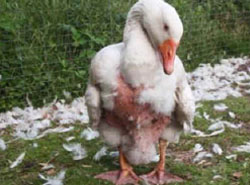
Down and Feathers are used for insulation and padding of products like jackets, bedding, sleeping bags and pillows. Most of these products contain a blend of down and feathers.
Down is the product with the highest value. It consists of the soft, fluffy undercoating that waterfowl like ducks and geese have to keep them warm. Land fowl like chickens don't have a lot of down feathers.
Feathers come in two types: flight feathers and body feathers. Flight feathers are found on the wings and tails of birds. They are larger and have a hard shaft running through the middle. These feathers are usually chopped up and used in lower quality bedding. Body feathers are found all over the body and have as function to insulate and protect birds. Their shafts are softer and have a curve, which makes them more suitable for use in bedding.
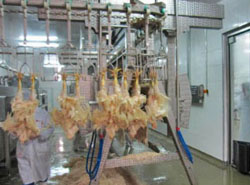
Slaughterhouse
Feathers of birds like ducks, geese or chickens are a profitable by-product of the poultry industry. Since consumers have a preference for young, tender poultry meat, birds are usually slaughtered around the time they go through their first moulting (when they drop their feathers to grow new ones).
The usual process to obtain the feathers is to first scald the birds in hot water for 1 to 3 minutes. Scalding isn't necessary, but makes it easier to remove the feathers. After that, the flight feathers are removed by hand. Next the body feathers and down are removed either by a plucking machine or by hand. The last step is to dry and sort the feathers.
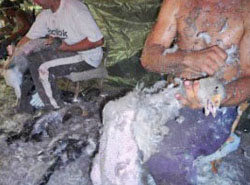
Feather Removal from Live Birds
Since birds like ducks and geese are bred in large groups for the production of meat and foie gras, "harvesting" their feathers is a profitable by-product. Feathers are usually removed during the natural moulting cycle of the bird, which is the time when they shed their old feathers and grow new ones, every 6-7 weeks.
Geese are usually not fed the day before their feathers are collected, to avoid them contaminating their feathers with droppings.
The general method of removing feathers is done by holding the goose down, usually with the head between the knees of the worker, which can cause suffocation or injury if not done correctly. The worker will then use one hand to hold the goose and the other one to remove the feathers.
Egg-laying geese have their feathers collected between 5 and 15 times during their lifetime. Geese raised for meat have their feathers collected about 4 times during their lives.
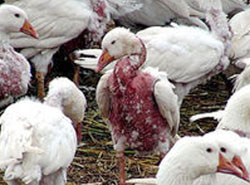
Gathering and Plucking
Feather gathering is the method where only ripe feathers are removed from a bird. Ripe feathers are feathers that are ready for shedding and which can be removed from a bird with minimal force and without tissue damage.
When feathers are plucked from birds, they are pulled out of their skins with force, leaving bleeding follicles and possible skin damage like tears and bruises. When non-ripe feathers are removed, they will often have tissue or blood attached to them.
Since commercial feather gathering is often done with flocks that contain thousands of birds, it is less feasible to only gather ripe-feathers. This means that feathers are both plucked and gathered.
The European Union forbids improper live-plucking. They do allow the "harvesting feathers and down from the live animal at the moment of molting" if carried out in accordance with certain rules.
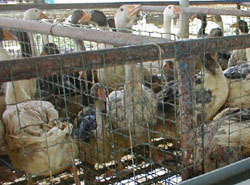
Feather and Down Production
The largest exporters of down and feathers are China and Hungary. All together, there are about 25 countries that have a significant production of down and feathers. They are located mainly in Europe, Asia and North America.
The China Feather and Down Industrial Association claims that only about 1-3% of feathers from their country come from live birds, whereas 97-99% is a slaughterhouse by-product. The European Down and Feather Association claims that about 98% of feathers are a by-product from the poultry meat production, leaving only 2% to come from live birds.
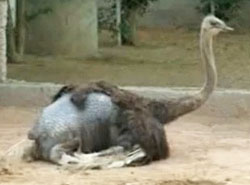
Ostrich Feathers
Ostrich feathers are used for house decorations, feather boas, masks, costumes or feather dusters. Most ostrich feathers you see on the market have been dyed in different colors.
Ostriches used to be raised exclusively for their feathers, but are now also raised commercially for their meat and leather. They are farmed in over 100 countries. Both in cold climates like Norway, Sweden or Alaska and warm climates like Brazil, Indonesia or Zaire.
They are kept on large farms in groups of thousands, where they are plucked alive. The usual method of plucking ostriches, is to drive them into an enclosure small enough so they cannot kick or turn around. Workers will then remove the feathers. This is usually done every 7 months of their lives. They are also plucked after they are slaughtered.
Swedish Documentary
In February 2009, a Swedish TV documentary studied the down industry for the popular television program "Kalla Fakta" (meaning "Cold Facts" in Swedish). This documentary estimated that between 50-80% of the world's down market comes from live birds. This was denied by the China Feather and Down Industrial Association. IKEA, the Swedish furniture company, independently verified that the 50-80% was correct, after which they cancelled an order from China for down-filled furniture.
The documentary also filmed undercover at a Hungarian goose farm. On their tape you can see geese lying on their backs screaming and struggling to free themselves, while their down is being ripped from their bodies. Afterwards you can see several birds lying on the floor with large flesh wounds. These wounds are then sown back together with needle and thread by the same workers, without any anesthetic.

